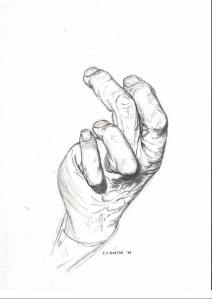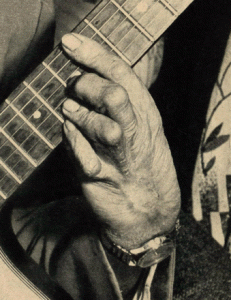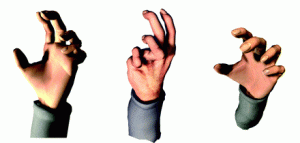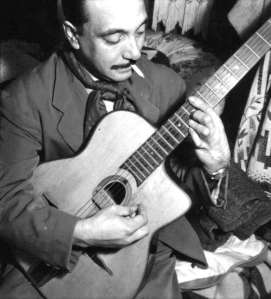Django’s Fret Hand & Fingerboard Technique
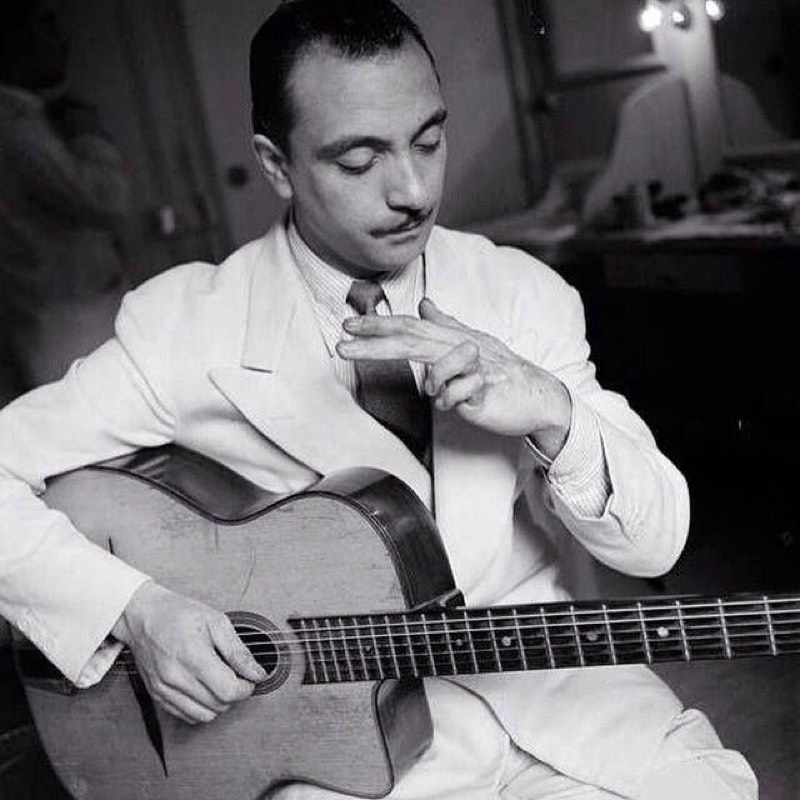
Django’s Fret Hand – On 2nd November 1928 an event took place that would forever change Django‘s life. At 1-o’clock in the morning, the 18-year-old Django returned from a night of playing Music at a New Club “La Java” (La JAVA, 105 rue du Faubourg du Temple 75010 Paris) to the Caravan that was now the home of himself & his new wife. The Caravan was filled with celluloid flowers his wife had made to sell at the market on the following day. Django upon hearing what he thought was a Mouse among the flowers bent down with a candle to look. The burning Wick from the candle fell into the highly flammable Celluloid Flowers & the Caravan was almost instantly transformed into a raging inferno. Django wrapped himself in a blanket to shield him from the Flames. Somehow he and his wife made it across the blazing room to safety outside, but his left hand & his right side from knee to waist were badly burned. He was admitted to the Hôpital Lariboisière in Northern Paris, but Initially, Doctors wanted to Amputate his leg but Django refused. On 22nd November he fled back to the Gypsy Encampments where he was treated with Traditional remedies.

His Wounds became Infected & he was Admitted to the Hôpital Saint-Louis on 23rd January 1929 for Debridement & Cautery with Silver Nitrate under Chloroform Anaesthesia. The burns slowly healed, but resulted in severe contractures of the Left Ring and Little Fingers which made conventional guitar technique He was moved to a Nursing Home where the Care was so good his leg was saved. Django was Bedridden for 18-months. During this time he was given a Guitar & with great determination, Django created a whole new Fingering system built around the 2-fingers on his left hand that had full Mobility. His 4th & 5th digits of the left hand were permanently curled towards the Palm due to the tendons shrinking from the Heat of the Fire. He could use them on the 1st 2 strings of the Guitar for Chords & Octaves but the complete extension of these fingers was impossible. His Soloing was all done with the Index & Middle Fingers! Film clips of Django show his technique to be Graceful & Precise, almost defying belief.
Django devised a highly efficient system of 3-Note Chord shapes, each of which encompassed inversions of several different Chords. He developed unorthodox techniques to play these, including the use of his left Thumb to Fret the lower 1 or 2 Strings, 1-Fingered “Double stops” – where 2-Strings are Fretted simultaneously by placing the Tip of 1-Finger midway between both Strings – and Employed his contracted Ring & Little Fingers on the Upper Strings, where they acted like a Single Finger. The last Technique particularly suited 9th or Minor 6th Chords rather than the more conventional Major or Minor Chords of the time & introduced his Audience to a new Range of Tonal Colours.

It is difficult to play standard scales with just Index & Middle fingers, so Django adopted an Arpeggio-based rather than Modal approach to Soloing. He adapted Arpeggios so that they could be played with 2-Notes per String Patterns which ran horizontally up & down the Fretboard instead of the usual Vertical “Box” Patterns, enabling him to move around the Fretboard with great speed & fluidity. Influenced by his childhood Violin Lessons, he often oriented his Left Hand so that these Fingers were almost Parallel to the Strings instead of Perpendicular to the Fretboard. His injuries also defined his Phrasing & Ornamentation – he often incorporated Open Strings into his Solos, along with his Trademark Chromatic Glissando Runs, for which he used his Middle Finger braced by the Index Finger – and the considerable Strength that he had to develop in these Fingers enabled him to achieve wide String Bending & Vibrato effects.”
 As a result of the relative immobility of his hand, Django often moved fixed Shapes up & down the Fretboard which produced Intervallic Cycling of Melodic Motifs & Chords & played Octave Runs with the Index & Middle or Ring Fingers – a Technique subsequently popularised by Wes Montgomery. Django’s Technique was only possible because of the remarkable Length & Span of his Index & Middle Fingers. Photographs show that he could play a “Barre” across the full width of the Fretboard using just the Distal 2-Phalanges of his Index Finger & a half-Barre with the Distal Phalanx of his Middle Finger and analysis of Film Footage shows that he could effortlessly span a distance of at least 120mm [4.7-inches] between the Tips of his Index & Middle Fingers.
As a result of the relative immobility of his hand, Django often moved fixed Shapes up & down the Fretboard which produced Intervallic Cycling of Melodic Motifs & Chords & played Octave Runs with the Index & Middle or Ring Fingers – a Technique subsequently popularised by Wes Montgomery. Django’s Technique was only possible because of the remarkable Length & Span of his Index & Middle Fingers. Photographs show that he could play a “Barre” across the full width of the Fretboard using just the Distal 2-Phalanges of his Index Finger & a half-Barre with the Distal Phalanx of his Middle Finger and analysis of Film Footage shows that he could effortlessly span a distance of at least 120mm [4.7-inches] between the Tips of his Index & Middle Fingers.
David J Williams, Consultant Anaesthetist & Senior Clinical Tutor, Tom S Potokar, Consultant Plastic, Reconstructive & Burns Surgeon & Senior Clinical Tutor
Department of Burns & Plastic Surgery, Morrison Hospital, Swansea SA6 6NL,
Swansea University Medical School, Singleton Park, Swansea SA2 8P
Williams & Potokar analysed the few minutes of surviving Film Footage of Django’s Playing. Their Analysis of this gives us some insight into the innovative Techniques that he developed to overcome the limitations imposed by his Injuries
Dr D.J. Williams & T.S. Potokar, “Django’s Hand”. BMJ 2009;339:b5348
Doctor David Williams Lecture @ Brecon 2009 – The Jazz Guitarist Django Reinhardt, limited by Burn Injuries, developed a Musical Technique that created a new Musical Genre. David Williams & Tom Potokar analysed archive Photographs to construct a 3-D Computer Model of his Injuries.
The instinctive response, when threatened by Assault or Fire, is to protect the face by raising the Arms, which exposes the Dorsum of the Hands to Injury. The thin subcutaneous Tissue & superficial Tendons in this Region make it vulnerable to subsequent Deformity. The ability to play a Musical Instrument also requires an Intact nervous system to provide Motor Fibres and Sensory Feedback from Cutaneous Touch Receptors and Joint Proprioceptors. Nerve damage was unlikely in Django’s case – the burn injury was on the dorsum of his hand: the digital nerves run deep on the volar aspect. The motor supply to his hand was unaffected and any sensory disturbance would have been confined to the dorsal aspect of his fingers, which would not have interfered with his ability to play the guitar.
Disaster can also be a positive catalyst for innovation. Modern reconstructive surgery would have dramatically improved the function and cosmetic appearance of Django’s hand, but would have perhaps changed the course of jazz music forever. The enduring popularity of Django’s music is a testament to his innate genius and determination.
Computer Model of Django’s hand illustrating the Deformity & Effect of Contractures
Django’s Playing
From the people most influential to the Development of Django’s distinctive playing style, 2 have been considered to rise above others: Poulette Castro and Gusti Malha. Poulette Castro, Player of the Banduria & other Stringed Instruments, performed mainly Waltzes and the more traditional Gypsy Repertoire with his Guitar playing brother Laro. Django at his early teens would watch them attentively for hours.
Poulette Castro was probably the primary model for Django‘s famous picking hand Technique so distinct from the American Jazz Guitarists: very fast, strong & accurate Wrist movement with the Hand & Arm loose at all times from the Top of the Instrument, thus allowing free movement with greater Power. Some Writers have argued that Django’s Physical Handicap actually made him a better Guitarist than had he the use of all 4-Fingers on his Fretting Hand. Unable to play the Linear, Scale-driven Lines that fall all too easily under the Fingers of most Guitarists, Django’s Limited Mobility forced him to view the Fingerboard more Vertically than Horizontally.
Blessed with exceptionally Large Hands & Long Fingers (one famous photo shows him fretting the High-E through A-|Strings of his Guitar at the 14th Fret with his Middle Finger from the 2nd Knuckle Down), he had the Strength & Stretch to make wide intervals with just his 1st 2-Fingers. He invented the use of Octave Runs as a Soloing Device on Guitar, another example of taking his 2-Fingered Limitation & making it a Musical Asset. Moving beyond that, he frequently used Double Stop Runs in Colourful Intervals to generate Tonal Tension & Resolution in his Solos. Django literally developed a new vocabulary for Lead Guitar, making wide interval jumps across the Strings as often as he moved up & down the Strings individually. When he did remain on 1-String, it was typically for a blistering Chromatic Run that might start on the 1st-Fret & run all the way up to the 13th-Fret. Always aware of the slightest Nuance of Tone, Django honed each note perfectly, often incorporating a beautifully modulated Finger Vibrato or a skilfully executed Blues Bend or Slur to add emotional strength to his Playing. As the Django Repertoire Books as notated by Guitarist Robin Nolan show clearly, most of Django’s Chord positions were simple 3-Note Chords, but his Musical Genius enabled him to create Diminished, Suspended & Augmented Chords that beautifully fit the Melodies he played by adding Open String Notes as needed. Although a total Illiterate Musically who couldn’t name any Chords, he always knew what Chord Formation he needed to create the Musical Effect he desired, either a sweet, lush Chord or a jarring, angular punctuation Chord, to set theMood.
Django taught his left fingers to Fret a Guitar anew. His 2-Small fingers were largely Paralysed, the Tendons & Nerves Damaged, the Digits nearly useless. His Index & Middle Fingers still Functioned, however & limited now in the number of Digits he could Employ to Fret the Guitar, he forced himself to rethink his Approach to the Fretboard. Instead of playing Scales & Arpeggios Horizontally across the Fretboard as was the Norm, he searched out Fingerings that ran Vertically up & down the Frets as they were easier to play with just 2 -Fingers. He created new Chord Forms that utilised a minimum of notes – often just Triads made with his 2 Good Fingers on the Bass Strings. He pushed his 2-Paralysed Fingers to Grip the Guitar as well, his smallest Digit on the High-E String, his Ring Finger on the B & sometimes Barring his Index Finger to fashion Chords of 4 to 5 Notes. He then Slid his hand up & down the Fretboard, employing these Chord Forms to Craft a Fluent New Vocabulary for Guitarists to Marvel at.

